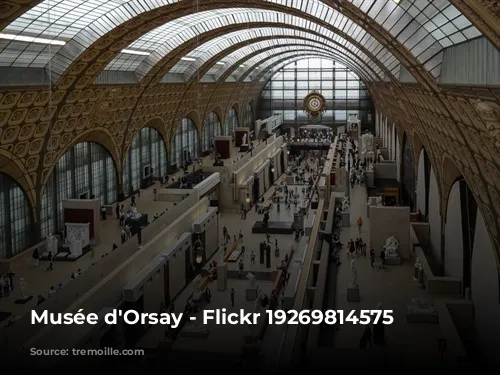Paris, the City of Lights, is renowned for its artistic heritage, boasting an astonishing 1,000 galleries and museums. Amidst this vibrant landscape, the Musée d’Orsay, located on the Left Bank of the Seine, stands as a testament to artistic brilliance. This ornate railway station, built at the dawn of the 20th century, is itself a work of art that now houses a treasure trove of Impressionist and Post-Impressionist masterpieces.
Imagine stepping into a grand railway station that has been transformed into a museum showcasing the most important collection of Impressionist and Post-Impressionist art in the world. You’ll also be able to admire sculpture, design, and photography from the same era. It’s a unique experience that blends history and art in a way that is truly captivating.

The Rise (and Nearly Fall) of a Historic Building
In 1898, architect Victor Laloux was commissioned to design a luxurious railway station, La Gare d’Orsay, that would harmoniously blend with the city’s existing architecture. The result was a magnificent structure that became a symbol of Parisian grandeur. However, the station’s fate took an unexpected turn as the advent of electric trains rendered its platforms too short. Uncertainty loomed, and in 1973, plans were made to demolish the disused station and replace it with a modern hotel.
Fortunately, the building’s historical significance intervened, and in 1978, the transformation into a museum began. This decision saved a piece of Parisian history and paved the way for a remarkable cultural destination.

A Symphony of Art and Architecture
The museum’s original features – the iconic arched glass roof, ornate windows, and traditional décor – were thoughtfully preserved, creating a harmonious blend of historic charm and modern exhibition space. Laloux’s architectural vision, combined with meticulous renovations, transformed the station into a sanctuary for art, bathed in natural light.
As you step inside, you’re greeted by a captivating tableau of 19th-century statues lining the central alleys of the ground floor. Explore the adjacent rooms to discover a collection of pre-Impressionist works – including Realist paintings by Courbet and Degas – representing Academicism, Symbolism, and Neoclassicism movements. On this floor, you can also marvel at early photographs showcasing the beauty of the natural world.
Venture into the Pavillon Amont to immerse yourself in the world of design, where hundreds of meticulously crafted ornate furniture pieces tell the story of craftsmanship through the ages.
Don’t miss the temporary exhibition space on the ground floor, where a constantly evolving array of curated expositions promises a fresh artistic experience with every visit. Click here to discover what exhibitions are currently captivating the museum’s visitors.

The Home of the Impressionists
The fifth floor is dedicated to the Impressionist masters, a true testament to the movement’s brilliance. Here, you’ll be captivated by Pissarro’s charming landscapes, Monet’s masterful depictions of light, Cézanne’s iconic Cardplayers, Manet’s ‘shocking’ Olympia, and Renoir’s exquisite portrayal of feminine sensuality.
Degas, a pioneer of Impressionism who considered himself a Realist, is also prominently featured on this floor.
As you soak in the art, take a moment to enjoy two breathtaking panoramas. One offers a magnificent view of the entire museum, while the other reveals a captivating panorama of Paris stretching towards Montmartre and the Basilica of the Sacré-Coeur.

Post-Impressionist Wonders
On the second floor, you’ll find the Post-Impressionists, excluding Cézanne, who is showcased on the fifth floor. The level is brimming with renowned works by Pierre Bonnard and Édouard Vuillard, as well as a collection of paintings from Frédéric Bazille.
However, the focal point of this floor is undoubtedly the work of Gauguin and van Gogh. Don’t miss Gauguin’s primitive sculptures and his captivating paintings inspired by his travels in Tahiti, especially his iconic Tahitian Women (1891).
Prepare to be mesmerized by van Gogh’s masterpieces, including The Church at Auvers (1890), a selection of his Self-Portraits, and Starry Night Over the Rhône (1888).

A Sanctuary for Art
The Musée d’Orsay has undergone extensive renovations, culminating in a 2011 completion, which has significantly enhanced the viewing experience. The addition of neutral walls, replacing the previously used radiant white, creates a more conducive environment for appreciating the subtle nuances of colour, especially in Impressionist and Academic works.
The museum has also implemented less intrusive display cases, fostering a harmonious dialogue between the artists showcased together. Improved lighting throughout the museum illuminates the intricacies of the paintings, creating a truly immersive experience. Monet himself would surely approve of this commitment to showcasing his work in its full glory.

A Parisian Must-See
The Musée d’Orsay bridges the gap between the Louvre’s collection (circa 1848) and the Centre Pompidou’s (circa 1914), providing an unparalleled glimpse into a pivotal period in art history.
Here, you’ll encounter the French innovators who transformed the landscape of painting, from the delicate brushstrokes of Monet to the raw emotion captured on van Gogh’s canvases.
A visit to the Musée d’Orsay is an essential experience for any art enthusiast seeking a captivating journey through one of the most prestigious art institutions in the world.








